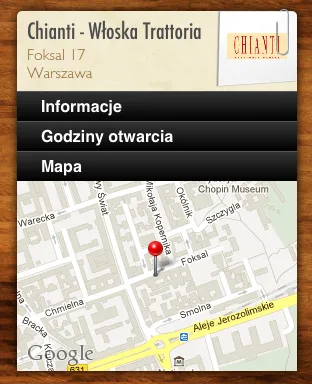这是我目前正在使用的
CollapsingTableViewDelegate 类来实现此功能。这仅适用于静态表格内容。
您需要向此类提供
CollapsingTableCellDelegate 实现,该实现必须知道如何计算每行的折叠和展开大小,以及如何为每行创建一个
UIView。视图在折叠或展开时保持不变,因此每行视图的顶部薄片作为该行的可点击标题。
然后,您将此类设置为
UITableView 的数据源和代理。
头文件
CollapsingTableViewDelegate.h:
#import <UIKit/UIKit.h>
@protocol CollapsingTableCellDelegate<NSObject>
@required
- (CGFloat)collapsingCellHeightForRow:(int)row expanded:(BOOL)expanded;
- (UIView *)collapsingCellViewForRow:(int)row;
@optional
- (BOOL)collapsingCellAllowCollapse:(int)row;
@end
struct cell;
@interface CollapsingTableViewDelegate : NSObject <UITableViewDelegate, UITableViewDataSource> {
id<CollapsingTableCellDelegate> cellDelegate;
int numCells;
int currentSelection;
struct cell *cells;
}
@property (nonatomic, retain, readonly) id<CollapsingTableCellDelegate> cellDelegate;
@property (nonatomic, assign, readonly) int numCells;
@property (nonatomic, assign) int currentSelection;
@property (nonatomic, assign, readonly) struct cell *cells;
- (CollapsingTableViewDelegate *)initWithCellDelegate:(id<CollapsingTableCellDelegate>)delegate numCells:(int)numCells;
- (void)tableView:(UITableView *)tableView touchRow:(int)newSelection;
@end
以及源文件 CollapsingTableViewDelegate.m:
#import "CollapsingTableViewDelegate.h"
@implementation CollapsingTableViewDelegate
struct cell {
u_char expanded;
u_char collapsable;
};
@synthesize cellDelegate;
@synthesize currentSelection;
@synthesize cells;
@synthesize numCells;
#pragma mark -
#pragma mark Setup and Teardown
- (CollapsingTableViewDelegate *)initWithCellDelegate:(id<CollapsingTableCellDelegate>)delegate numCells:(int)num {
if ([super init] == nil)
return nil;
if ((cells = calloc(num, sizeof(*cells))) == NULL) {
[self autorelease];
return nil;
}
cellDelegate = [delegate retain];
numCells = num;
for (int row = 0; row < self.numCells; row++) {
struct cell *const cell = &self.cells[row];
cell->collapsable = ![self.cellDelegate respondsToSelector:@selector(collapsingCellAllowCollapse:)]
|| [self.cellDelegate collapsingCellAllowCollapse:row];
cell->expanded = !cell->collapsable;
}
currentSelection = -1;
return self;
}
- (void)dealloc {
[cellDelegate release];
free(cells);
[super dealloc];
}
- (void)tableView:(UITableView *)tableView reloadRow:(int)row fade:(BOOL)fade {
[tableView reloadRowsAtIndexPaths:[NSArray arrayWithObject:[NSIndexPath indexPathForRow:row inSection:0]]
withRowAnimation:fade ? UITableViewRowAnimationFade : UITableViewRowAnimationNone];
}
- (void)tableView:(UITableView *)tableView touchRow:(int)newSelection {
if (newSelection < -1 || newSelection >= self.numCells) {
NSLog(@"CollapsingTableViewDelegate: invalid row %d not in the range [-1..%d)", newSelection, self.numCells);
return;
}
int oldSelection = self.currentSelection;
BOOL sameCellSelected = newSelection == oldSelection;
struct cell *const oldCell = oldSelection != -1 ? &self.cells[oldSelection] : NULL;
struct cell *const newCell = newSelection != -1 ? &self.cells[newSelection] : NULL;
if (newCell != NULL)
newCell->expanded = TRUE;
if (oldCell != NULL)
oldCell->expanded = FALSE;
self.currentSelection = sameCellSelected ? -1 : newSelection;
if (oldSelection >= newSelection) {
if (oldSelection != -1)
[self tableView:tableView reloadRow:oldSelection fade:sameCellSelected];
if (newSelection != -1 && !sameCellSelected)
[self tableView:tableView reloadRow:newSelection fade:TRUE];
} else {
if (newSelection != -1 && !sameCellSelected)
[self tableView:tableView reloadRow:newSelection fade:TRUE];
if (oldSelection != -1)
[self tableView:tableView reloadRow:oldSelection fade:sameCellSelected];
}
if (newSelection != -1 && !sameCellSelected) {
[tableView scrollToRowAtIndexPath:[NSIndexPath indexPathForRow:newSelection inSection:0]
atScrollPosition:UITableViewScrollPositionTop
animated:TRUE];
}
}
#pragma mark -
#pragma mark Table view data source
- (NSInteger)numberOfSectionsInTableView:(UITableView *)tableView {
return 1;
}
- (NSInteger)tableView:(UITableView *)tableView numberOfRowsInSection:(NSInteger)section {
return self.numCells;
}
- (CGFloat)tableView:(UITableView *)tableView heightForRowAtIndexPath:(NSIndexPath *)indexPath {
int row = [indexPath row];
struct cell *const cell = &self.cells[row];
return [self.cellDelegate collapsingCellHeightForRow:row expanded:cell->expanded];
}
- (UITableViewCell *)tableView:(UITableView *)tableView cellForRowAtIndexPath:(NSIndexPath *)indexPath {
int row = [indexPath row];
UIView *cellView = [self.cellDelegate collapsingCellViewForRow:row];
[cellView removeFromSuperview];
UITableViewCell *tvcell = [[[UITableViewCell alloc] initWithStyle:UITableViewCellStyleDefault reuseIdentifier:nil] autorelease];
[tvcell.contentView addSubview:cellView];
tvcell.clipsToBounds = TRUE;
tvcell.selectionStyle = UITableViewCellSelectionStyleNone;
return tvcell;
}
#pragma mark -
#pragma mark Table view delegate
- (NSIndexPath *)tableView:(UITableView *)tableView willSelectRowAtIndexPath:(NSIndexPath *)indexPath {
int row = [indexPath row];
struct cell *const cell = &self.cells[row];
return cell->collapsable ? indexPath : nil;
}
- (void)tableView:(UITableView *)tableView didSelectRowAtIndexPath:(NSIndexPath *)newSelection {
[tableView deselectRowAtIndexPath:newSelection animated:TRUE];
[self tableView:tableView touchRow:[newSelection row]];
}
@end
并不完美,但对我来说基本上可以工作。
